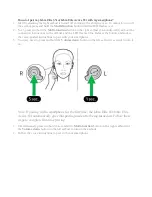
C
HAPTER
7
| Wireless Configuration
Advanced Settings
– 71 –
threshold, the RTS/CTS (Request to Send / Clear to Send) mechanism
will be enabled.
The access points contending for the medium may not be aware of each
other. The RTS/CTS mechanism can solve this “Hidden Node Problem.”
(Range: 1-2347 bytes: Default: 2347 bytes)
◆
Short Preamble
— Sets the length of the signal preamble that is used
at the start of a data transmission. Use a short preamble (96
microseconds) to increase data throughput when it is supported by all
connected 802.11g clients. Use a long preamble (192 microseconds) to
ensure all 802.11b clients can connect to the network.
(Default: Disabled)
◆
Short
Slot
— Sets the basic unit of time the access point uses for
calculating waiting times before data is transmitted. A short slot time
(9 microseconds) can increase data throughput on the access point, but
requires that all clients can support a short slot time (that is, 802.11g-
compliant clients must support a short slot time). A long slot time
(20 microseconds) is required if the access point has to support
802.11b clients. (Default: Enabled)
◆
TX Burst
— A performance enhancement that transmits a number of
data packets at the same time when the feature is supported by
compatible clients. (Default: Enabled)
◆
Packet Aggregate
— A performance enhancement that combines data
packets together when the feature is supported by compatible clients.
(Default: Enabled)
W
I
-F
I
M
ULTIMEDIA
The Mini Broadband Router implements Quality of Service (QoS) using the
Wi-Fi Multimedia (WMM) standard. Using WMM, the access point is able to
prioritize traffic and optimize performance when multiple applications
compete for wireless network bandwidth at the same time. WMM employs
techniques that are a subset of the developing IEEE 802.11e QoS standard
and it enables access points to interoperate with both WMM-enabled clients
and other devices that may lack any WMM functionality.
WMM defines four access categories (ACs): voice, video, best effort, and
background. These categories correspond to traffic priority levels and are
mapped to IEEE 802.1D priority tags (see
Table 3
). The direct mapping of
the four ACs to 802.1D priorities is specifically intended to facilitate
interoperability with other wired network QoS policies. While the four ACs
are specified for specific types of traffic, WMM allows the priority levels to
be configured to match any network-wide QoS policy. WMM also specifies a
protocol that access points can use to communicate the configured traffic
priority levels to QoS-enabled wireless clients.
Содержание SMCWBR11S-N
Страница 1: ...BarricadeTM N 150Mbps Wireless N Mini Broadband Router SMCWBR11S N USER GUIDE...
Страница 137: ...SMCWBR11S N...
















































